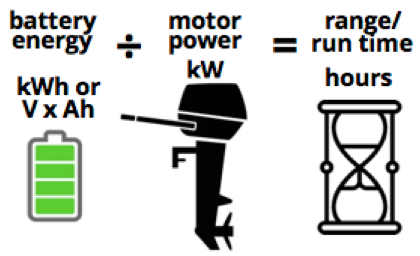All electric, charged by the sun
An unusual but unique feature is the engines on board. Instead of a traditional set of inboard diesel powered engines, S/Y Tossan is equipped with two outboard electric engines. Combined with the solar panels you are in no need to find a gas station or challenge of running dry. This sets you up for a fully sustainable life on the water.
- Engines: 2 x Torqeedo Cruise 10.0 FP
- Power: 2 x 10.3 kW ≈ 2 x 20 HP (comparable gasoline outboard motor)
- Electronic controls, mounted on a moveable pod with a 5-meter cord
- Two separate battery banks (48V), one per engine. See Power system for more info on batteries etc.
The use of two electrical engines make S/Y Tossan quiet and easy to handle. Both engines can be slightly rotated manually as well as sunken into, or raised out of, the water as needed. The engines can be operated in the same direction to provide a forceful thrust or operated in opposite directions to rotate the yacht on the spot.
Capacity
A common question is how far or how long S/Y Tossan can go on one charge. The answer obviously depends on external factors such as wind speed, wind direction, wave height, and additional weight. A simple calculation using boattest.com’s suggested calculations the capacity of the engines is as per below.
Using the simple formula to the right, it shows the capacity of the engines at full throttle. Battery energy = 48V x 250 Ah. Motor power = 10.3 kW (continuous input power). Run time = 1,16 hours (70 minutes) at full throttle.
The normal scenario is of course that you never need to use the absolute full throttle all the time, but the table to the right gives a hint of the capacity at hand. Different to gasoline or diesel driven engines, in sunny conditions the solar panels will continuously charge the batteries with a maximum capacity of 6 x 300 W = 1.8 kW per hour. See Power system for more information.
Runtime test
In September 2023, in Alvor, Portugal, we performed a runtime test while doing a test sailing.
Test setting:
- Conditions: Low tide, limited current and full sunshine (should have been full charge from solar panels), early September
- Distance covered: ~1.8 nm x 2 = ~3.6 nm
- Average power per engine: 900W
- Speed: 3-4 knots
- Runtime: 60 minutes
- Charging: 3 hours, during the course of the full sailing trip

(image courtesy boattest.com)
| Speed | Run time |
|---|---|
| Full speed (100%) | 70 minutes |
| Half speed (50%) | 140 minutes |
| Quarter speed (25%) | 280 minutes |
From the mooring we cruised by engines all the way out to the channel/river exit to the Atlantic Ocean. Average speed was about 3-4 knots with an average power per engine of 900 watts. We used the engines for about 30 minutes, then sailed for about 2 hours, and then came back by electric engines around 30 minutes. The solar panels were charging the full time, a total of 3 hours.
➡️ Result: the battery indicator for the 48V system had dropped seven percentage points (7 pp). 👍🏻👍🏻👍🏻
Additional links
- What is an electric outboard motor? (EClass Outboards)
- Electric propulsive power explained (EClass Outboards)
Data sheet
Below a table from Torqeedo’s data sheet for the Cruise 10.0 FP TorqLink. Below values is per engine. S/Y Tossan is equipped with two engines and weighs 7 tonnes.
| Attribute | Datapoint |
|---|---|
| Model | Cruise 10.0 FP TorqLink |
| Appropriate boat weight | Up to 10 tonnes |
| Maximum input power | 12 kW |
| Continuous input power | 10 kW (may differ due to the combination with propeller and boat) |
| Rated voltage | 48 V |
| Continuous propulsive power | Max. 5.6 kW |
| Weight of pylon | 26 kg |
| Weight of electronics box | 7 kg |
| Weight of cable set | 9 kg |
| Max. propeller shaft rotational speed | 1400 rpm |
| Steering | Accelerator lever |
| Stepless forwards/reverse motion | Yes |






